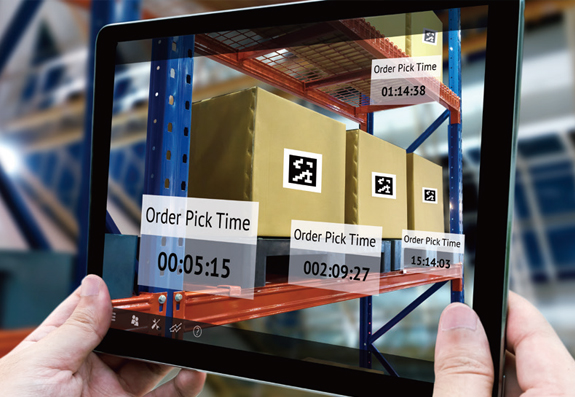Supply Chain, Implanted with Data and
Completed with Analysis
Supply Chain Intelligence
As online technology is rapidly integrated into offline, there is a huge wave of change in logistics. It is changing into a predictable, expandable, and advanced logistics system by combining data and analysis functions with processes that have relied on human judgment. The change is fast and astonishing enough to be called an innovation. Let us look at the current supply chain intelligence at the center of the change, and try to predict the future.

The origin of the concept of supply chain intelligence
Logistics is driven by Supply Chain Management (SCM). It is called the supply chain because the supply network that connects market participants is closely connected, throughout the products from raw material suppliers to manufacturers, and wholesalers to retailers. Supply chain management is managing a complex supply network using various media and technologies. Traditionally, it has relied on manpower because there are so many variables.
With the development of the Internet, communication and real-time information sharing between people in charge of supply chain management have improved, but dealing with variables that can occur during the process and predicting the future had to be done by people.
With the development of the Internet, communication and real-time information sharing between people in charge of supply chain management have improved, but dealing with variables that can occur during the process and predicting the future had to be done by people.
This is when the need for improvements in supply chain management arose. COVID-19 pandemic also played a role here. As consumer demand rapidly shifted from offline to online, the volume of offline transactions declined sharply, while online transactions increased exponentially. This is because, as the demand for suddenly digitalized supply chain management grew, it was difficult to respond quickly with the existing system that was managed by people.
When the pandemic ends and people go back to their normal lives, another flexible change may be required for the supply chain management, but COVID-19 will not be the only variable. In the future, more unpredictable variables may constantly interfere with the supply chain. After all, the advancement of supply chain management must start with accurate forecasting based on data. This is the starting point of the concept of “supply chain intelligence.”
When the pandemic ends and people go back to their normal lives, another flexible change may be required for the supply chain management, but COVID-19 will not be the only variable. In the future, more unpredictable variables may constantly interfere with the supply chain. After all, the advancement of supply chain management must start with accurate forecasting based on data. This is the starting point of the concept of “supply chain intelligence.”
Technology that brought innovations in inventory management and transportation
Supply chain intelligence performs various analysis functions such as process optimization, demand planning, and quality control, based on the data extracted from the supply chain management system. The analyzed information is shared in real time with the supply chain participants, and various predictions and response models are provided for variables that occur, so that the overall supply chain operation is maintained in the best state.
The advancement of supply chain management was possible because digitalization accelerated and data innovations such as the Internet of Things, machine learning, and artificial intelligence and advanced automation innovations were achieved. With the realization of supply chain intelligence, tremendous changes are taking place throughout the system. It is melting into the whole industry, creating more services, more value, and a faster and cheaper logistics.
First of all, in the inventory management sector, autonomous mobile robots controlled by artificial intelligence, automated classification systems based on block chain and IoT, and AI systems that predict demand through data and machine learning technologies are being used.
If the traditional supply chain management was simply showing the real time inventory information to the manager, the supply chain intelligence performs updates on its own, such as re-ordering when a certain product demand rises or inventory drops to a certain level, and effectively manages inventory by predicting the consumer demand patterns based on the data. For suppliers, inventory management is the starting point of the supply chain management. No matter how high the speed of the logistics is, supply chain management is meaningless without an advanced inventory management. Accordingly, the global distribution giants such as Amazon, Walmart, etc. are making astronomical investments every year to advance inventory management by digitalization and automation of distribution centers.
Also, in the transportation sector, it was the people who have been collecting, entering, sharing everything from the shippers’ quote requests to delivery. Now, through the supply chain intelligence system, the errors in this process are completely eliminated. At the same time, when delivering products to consumers, the optimal transportation method and routes are provided by AI, not humans, according to the traffic conditions for autonomous vehicles, robots, drones, etc., enhancing the quality and competitiveness of logistics services.
The delivery robots of Korean delivery app and the delivery robots and drones of Amazon and FedEx are the representative examples. The reason they were able to become commercialized is that we have reached the level where we can manage risks, variables, and safety issues that can occur throughout delivery based on massive data.
The peak of the industry advancement with data analysis and prediction
Data analysis abilities not only accelerate the digital transformation of supply chain management and change the future of the whole logistics, but also affect various industries. A representative example is the satellite image machine learning technology that analyzes the images taken by the satellites with AI. With the introduction of SpaceX's rocket launch vehicle recycling technology, the cost of operating and utilizing satellites has significantly lowered, and the barriers to entry have been lowered enough to actively utilize the data collected by the satellites for business.
For example, Orbital Insight, a geographic information data company in Silicon Valley, provides a service to predict logistics time through the satellite images of the containers in international ports. In addition, Descartes Labs, an American smart farm startup, is introducing a service that predicts the expected yield and the futures prices traded on futures exchanges by analyzing the satellite image colors of the grains grown in the Americas such as beans, wheat, and corns. This is a good example that shows how advanced the chain supply management can be depending on the scope and volume of data collected.
Challenges and future of supply chain intelligence
According to ZDNet, a media source specializing in IT, the global supply chain intelligence market is expected to grow from US$500 million in 2017 to US$25 billion in 2025. In addition, the analysis of Logistics IQ, a logistic market consulting firm, predicts that the global supply chain intelligence market will expand to US$75 billion by 2030. This means that the huge capital in logistics will be concentrated on the establishment of supply chain intelligence in the future. This is because the supply chain advanced by data and AI guarantees an expandable logistics system that is less expensive in the long term and far more accurately predictable than human management.
Even at this moment, digital transformation based on data is accelerating for all businesses, both online and offline. As the demand for advancement of supply chain management increases, the supply chain providers (countries, companies, organizations, etc.) are faced with the task of securing competitive advantage through further advanced digital and automation innovations. In addition to securing a competitive advantage, finding a way to integrate data and flexibly connect with other supply chain partners was also given as an assignment. After all, the supply chain provider who responds quickly to this trend and takes possession of it will eventually become the logistics leader that dominates the entire supply chain.

2022.02.01

